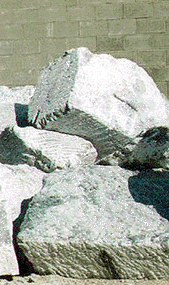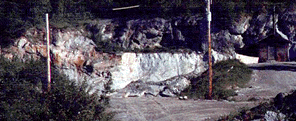|
Properties of Soapstone
 Varieties
of carving stone often referred to as Soapstone. Varieties
of carving stone often referred to as Soapstone.
Steatite is a massive and compact rock containing more
than 90 % talc. The remainder consists of silicates (chlorite)
and/or magnesium carbonates.
Soapstone is a massive, soft, impure talc rock that
contains variable proportions of magnesian carbonates (dolomite
and/or magnesite), serpentine, chlorite, tremolite and magnetite.
Pyrophyllite is a hydrated aluminum silicate. In contrast
to talc, pyrophyllite is the product of hydrothermal alteration
of felsic igneous rocks (rhyolite, dacite) and schists derived
from metamorphosed volcanic ash. Nonetheless, its physical properties
are identical to those of talc, and it therefore provides an
ideal substitute for talc in a number of industrial applications.
Breunerite is ferroan (iron-rich) magnesite.
 Soapstone is a metamorphic rock having a
talc base ("metamorphic" means changing from one type
of stone to another through time and pressure). It occurs as
a secondary mineral formed as a result of the alteration of olivine,
pyroxene,and amphibole. The purest talc is used commercially
to make talcum powder. Soapstone can be distinguished by its'
ease of carving, soapy feel, and vibrant colour, which is obtained
by the associated minerals leaching into the talc. Soapstone is a metamorphic rock having a
talc base ("metamorphic" means changing from one type
of stone to another through time and pressure). It occurs as
a secondary mineral formed as a result of the alteration of olivine,
pyroxene,and amphibole. The purest talc is used commercially
to make talcum powder. Soapstone can be distinguished by its'
ease of carving, soapy feel, and vibrant colour, which is obtained
by the associated minerals leaching into the talc.
 Because of its malleability, it has been
used as a carving material for centuries. Egyptians carved figures
and bowls of soapstone to be put into the tombs of pharaohs.
Soapstone seals of Indian origin have been found in Bahrain and
Ur. Paleoeskimos were mining the stone to make bowls and lamps
on the Baie Verte Peninsula 1600 years ago. Native American Indians
throughout North America carved soapstone into ornamental pipes
and bowls. Because of its malleability, it has been
used as a carving material for centuries. Egyptians carved figures
and bowls of soapstone to be put into the tombs of pharaohs.
Soapstone seals of Indian origin have been found in Bahrain and
Ur. Paleoeskimos were mining the stone to make bowls and lamps
on the Baie Verte Peninsula 1600 years ago. Native American Indians
throughout North America carved soapstone into ornamental pipes
and bowls.
 Soapstone is available world wide, the colour
of soapstone varying according to location and the proximity
of various mineral deposits in the area. Soapstone contains talc
and chlorite. The parent rock is peridotite, probably with more
water associated with it than in the formation of serpentine.
Many minerals mix readily with soapstone, creating the hues and
markings that intrigue the observer of a sculpture. I work in
the dark green and black soapstone of the eastern townships of
Quebec, but the colours vary throughout the continent and the
world. In China there is pale green and pink soapstone some of
which I have seen and used; in Russia and Alaska there is black
soapstone. Montana produces a dendritic soapstone having the
look of moss growing through the stone. Pyrite crystals (fool's
gold) can also be found within the stone showing as golden flecks.
Dolomite is the mineral that determines the hardness of the soapstone
that I work on. Some stone can be very easy to work and other
pieces extremely hard. Soapstone is available world wide, the colour
of soapstone varying according to location and the proximity
of various mineral deposits in the area. Soapstone contains talc
and chlorite. The parent rock is peridotite, probably with more
water associated with it than in the formation of serpentine.
Many minerals mix readily with soapstone, creating the hues and
markings that intrigue the observer of a sculpture. I work in
the dark green and black soapstone of the eastern townships of
Quebec, but the colours vary throughout the continent and the
world. In China there is pale green and pink soapstone some of
which I have seen and used; in Russia and Alaska there is black
soapstone. Montana produces a dendritic soapstone having the
look of moss growing through the stone. Pyrite crystals (fool's
gold) can also be found within the stone showing as golden flecks.
Dolomite is the mineral that determines the hardness of the soapstone
that I work on. Some stone can be very easy to work and other
pieces extremely hard.
 I often am asked about asbestos in soapstone.
The question probably derives from the fact that talc and asbestos
are part of the same metamorphic family of rocks and may often
exist in the same area. . The serpentinized ultramafic rocks
that host asbestos deposits may also contain talc and viceversa.
If asbestos were present in the soapstone, the veins of asbestos
would appear as cotton like and fibrous and are quite identifiable.
For further geological information on the formation of soapstone
(click here) I often am asked about asbestos in soapstone.
The question probably derives from the fact that talc and asbestos
are part of the same metamorphic family of rocks and may often
exist in the same area. . The serpentinized ultramafic rocks
that host asbestos deposits may also contain talc and viceversa.
If asbestos were present in the soapstone, the veins of asbestos
would appear as cotton like and fibrous and are quite identifiable.
For further geological information on the formation of soapstone
(click here)
 If you are really concerned, reputable talc
quarries can furnish an analysis of the soapstone indicating
the presence of asbestos, if it is present in the stone. If you are really concerned, reputable talc
quarries can furnish an analysis of the soapstone indicating
the presence of asbestos, if it is present in the stone.
 I obtain my stone from Les Pierres Stéatites
Inc. at St. Pierre de Broughton, Quebec. They mine their stone
by cutting and using wedges to break the stone from the wall
of the quarry. The stone is then taken to the mill and cut into
appropriate sizes for carving. Here
is a pictorial of the process. I obtain my stone from Les Pierres Stéatites
Inc. at St. Pierre de Broughton, Quebec. They mine their stone
by cutting and using wedges to break the stone from the wall
of the quarry. The stone is then taken to the mill and cut into
appropriate sizes for carving. Here
is a pictorial of the process.
For other occurences of talc
in the province of Quebec, (click
here)
If you have other questions, Email
Me
 The Old Broughton Soapstone Quarry
The Old Broughton Soapstone Quarry
{Showdates
Past and Future} {Biography} {Introduction to Carving} {Basics
of Carving}
{Sources of Soapstone} {Sources
for Tools}{Soapstone} {Quarrying
Soapstone} {Repairing Soapstone}
{Carve a Loon} {Carve
a Polar Bear} {Carve an Eagle}
{Carvings on Hand} {Archived
Carvings}
{Malvina Hoffman} {Ropey
Atsiqtaq} {Links} {Inuit
Art Beginnings} {50 years of Inuit
Art} |

 Varieties
of carving stone often referred to as Soapstone.
Varieties
of carving stone often referred to as Soapstone.